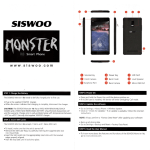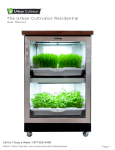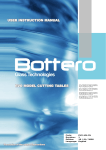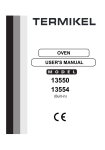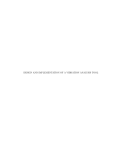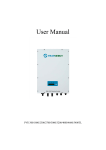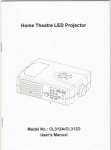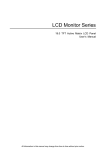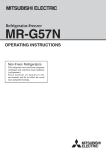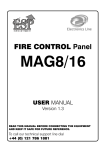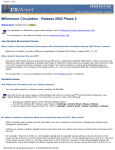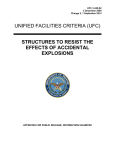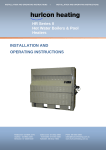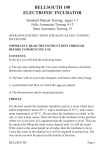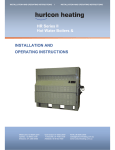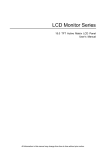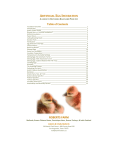Download Instruction: What you will find inside your packaging:
Transcript
Instruct∶ on: Whatvou wⅡ 苎 二 望:n引 ± ⊥ our packaJng: Foam protection Incubator POWer cord Instruction booklet κEV: 1 Testing your unit for the Ⅱrst time 2 setting the temperature 3Temperature alarm parameterse仗 ings(ALand AH) 4Humidky alarm parameter setungs(As) 5.Ca"brating temperature sensor reading(CA) 6,Temρ erature Upper and I° werlim"set(Hs and Ls) 7.Heating Element(Hu and HD) 8.DisplaV symbOIs 9,Using vourincubator 1.Testing vou un∶ t for the】 rst t"η e: 11Conned the egg turner plug to the control plug inside the egg compartment. 】,2ConneCtthe provided powersuppIy to the baCk ofthe unit and your 13sWitCh on your powersource ρowersource 、 1,4switch your unit on. 1.5Υ ou WilI hear an aIarm sounding due to low temperature/humidky, 1.6Press any ofthe green bu仗 ons to cancelthe alarm, 1.7By oρ ening the incubator and f""ng the、 ″ater channels you w"l notice the humidity reading increase 18Let the unit run for2hours to note the egg turnerturning. 22Push fJ+″ or ffˉ ″ to select the desired temperature, 2,3Push″ sET” once more to exit。 ˉThese incubators are fadory set at38° C,Ifound the chicks hatch at day19to 201neaning the temρ erature being to high。 using the rnethod as described above.lrecommend you setthe temperature at37.6° C 3.Temperature alarm parameter settings(ALand AH) The temρ erature aIarm is factopˇ setto sound at1° C over or below the settemperature This is su仃 icient and you do not need to rnake any changes to these settings 31LOW temperature alarm parametersetung.(ALl 3,11Press and hoId“ sEW′ for3sec. 31.2Push jf+″ 313Push or Jfˉ ″ sET″ ″unt"Code饣 aρ pears in the temperature screen. ^1″ ″ 314Push ff+″ or″ ˉ to adjust to your desired lower aIarm se伎 ing 32H℃ her arameter setung(AH) temρ erature aIarm ρ ′ ′ sET了 for3sec ′ ″ 2Push″ +″ or″ ˉunul code″ AH′ aρ pearsin the temperature screen 3,2,1Press and hoId‘ | 32・ 323Push ″ sEt” 32,4Push″ +″ ″ or″ ˉ to adjust to y° ur desired higher aIarm setting I帛 i艹 榀 suff cl血 m"⑾ should not deed to make anV changes to these settings 4,1Low humid"y alarm parameter setung(^s) 42Press and hold″ s曰 T″ for3seC ″until Code″ apρ earsin the temperature screen 43Push″ +” or″ ˉ ″ ^s″ 44Push sE7′ ′ ′ 4.5Push″ +’ or″ ˉ to adjust to your desired lower alarm setting. -By fⅡ both leVeIs water Channels the humidity shouId to60%dependant the channeIs local "ng humidity and the tirne of year ltend to rise f"lboth mV、 ″ater on eVery4to5day$and at day18When lremove the egg traysI OVerf"lthen∩ to increase the humiditV to about65% 措 en byt№ therm⑾ mr can be adjusted if Vou find that the temperature reading is incorrect using a ca"brated thermδ meter 5.1Calibraung the temperature sensor measurement.(CA) 52Press and h0ld fJsETT″ for3sec s.3Push″ +″ ″ or″ ˉ until code″ C^″ appearsin the temperature screen 54Push JfsET″ 5,5Push″ +″ or fJˉ ″to adjust to the correct rneasurement. -Note that the adjustmentis the di矸 erence between the thermometer readings and shouId be adjusted、 ″ith″ -“ if the temperature reading of the incubatoris to high and normaI value(indicating+value)f the incubator reading is too low. -2- 黯器措H髁瞿拙黠黯黜罐字 the de澜 temperature setting oncubaung temperature a曲 ustmentl lf Hs is set as38.2and Ls is set as37,4`then the desire temperature(incubating temρ e冂 ture a苟 ustment)can onIy be changed from382to37.4,so the minimum temperature sha"be Iirnited to37,2eVen if the″ -″ is kept on pressing,The same goes for the High set Lirnit. -This is to preVent accidental out of range temperature setting, 7.D∶ spIaV svmbols 廴 r}丨 乒 -3- f咖 灬 properl弘 2,Conned the egg turner pIug to the control plug inside the egg compartment 3.FⅡ I One or both water channe丨 s depending on local humidity Ievels 4.set the eggs、 ″ith the pointy side down 5,CIose the lid and switch on the incubator. 6,Press the reset button(left green button)to reset and start the dav counterfron∩ ″ 0″ , 茹瑟弼n涮 sw№ nm刨 扯 苫 P洋 泔 ∶ 沽湍苜 〗 ⒎ 牝 嬲 拈£ g mechamsm a嗣 d犯 e汛 ay M曲 血 lem。 ve讪 揣首 JTu;牦 "俪 mσ ease伽 mm‘ ∞ 由 ht∞ Ⅲ th唰 σ 堪 ⒐i巴 t点 :狩 湍繁 I里 %石 e讦 lI;f∶ :了 1∵ b。 are so仅 enough for humiditV“ thlsis veγ Important to ensure that the eggsheI‘ the chicks to break through) d when rhe ch衍 ks sr口 rr ro h口 rch Ifyou do`the loss of 10 you shourd never ope刀 Che′ ′ humiditV W"l cause the eggshe"s ofthe unhatched eggsto dn`out and they won′ t able to break through the egg Incubating tips Egg and incubator hygiene ProPer hygiene is essenualto acheve good hatching results Poor hygiene causes chcks to die in their nrst1o days of hfe ∶ i:釜 I瑟 蒜 潸 喁 嚣 t: the h(:日 11bator.If you need to incubate dirty eggs、 wash them firstin warm water (狃 Ⅵ9° C)that contahs山 欲“ectant at a rate recommended by the manufacturer ;∶ ∶ 鲫 ∶ ∶ :∶ ∶ ∶ ;丨 l∶ 丨 lm° st h° usehold ;∶ ll∶ 糕 舞 于 茫 :∶l∶ disinfedants are su⒒ able)、 and dry the eggs quickly aRer 躐勰 ξ 嚣圪 ∶ 弘 ∶括 :皙 :!满 紧嚣l菡 丑 ::∶ 1】 ° ::ξ:∶ 1留 芦 Ι 槭 槲 硼耕 槲 揪鞴 藕 -4ˉ formalh lsee Table1for the coⅡ ect amounts for each applicatonl Place the chen1icals L`a dish on the noor。 f the incubator.Place the Condy′ s crystals into the dish Hrst and then pour the fonmahn overit,shut the incubator door quick1y and vacate the room, For proPer fun讧 gauon/rtm ute ma。 hine norma⒒ y with the correct temperature and hun讧 d扯 y.After20minutes/open the vents orthe door and airthe machine £ or a few minutes,Aga屺 vacate the room Healthy stock It is i1nportant that eggs fr° n△ onIy a healthy n。 ck are used for hatching`assome diseases can be transn、 itted through the egg The eggˉ transmittabIe diseases to be most aware of are sa1mone11a infeCu。 ns、 fowl饣 ph0d 8夕 JJ泌 印 fJc′ 仰 and Λ亻ycoPl日 s〃 夕 Eggs laid by birds infected wid`disease1nay faⅡ to hatch。 ofthose that do hatch、 some birdsrnay die durhg broodh1g/and the survivors rnay act as carriers and infect healthy chcks Do notadd eggsfrom unknown sources toェ nake up numbers`as you risk infecting your nock, Breeding stock nutrition The egg provides a comPlete food store for proper embryo development excePt gaseous oxygen`which enters the egg through pores in the she11.Breeding stock mustbefed a we11-balanced diet to funy rneet J.eemb叩 os’ nutrient requirements The dencient nu汀 ients are usua1ly vitamins or m1nera1s A denciency ofthese in the breeders’ diet may notshow any i1l effects in the breeders、 hatchabiIity may be affected、 though which心 why different categories are fed sPecinc diets.Nutritiona1de伍 ciendesJ such as a lack of Hb° navin、 are the rnain causes of embryo mortality durL1g the middIe乩 age ofincubaton C,e between the12th and1在 th days), Hens1v⒒ aⅡ nmeral requirements for Iaying eggs are lower than those of I卜 ■Ⅰ `in and【 breeders The breeder’ s diet should begm six to eight weeks before hatching eggs are required、 with parhα Ⅱar attenu。 nt。 vita∏ Il■ vitam山 nB12 D3、 `in A、 ribonaviI.panto曲 enic rrⅠ 鑫嘈 禽 露 废砷姣烀 | 簿‖ 裰 Age of bFeeding stock If the rnale bird is active、 nottoo large or overweigh1and ferule`his age has htde or no effeCt on hatchabi1ity orthe vigour ofthe chicks The older the cock bird` and the fewer hens he can mate effecuvdy withoutloss of fertility Fertili〃 hatchabⅡ ity also decrease、 asthe henis egg producuon drops Ⅵ冖th age、 and is highest during her first and second laying season. Hatching eggs selection Itis irnportant to consider the size`shaPe and shelltexture When selecung eggs for hatching,Best results are obtained by setting eggs that are around the average egg、 ″eight for the type of poultry, the r(:jeCton ofsmalleggs wⅢ since egg s弦 e o highly heritable、 hdp to maintah good egg size in the progeny Extra large or smalleggs are a handicaP in the so continual use of badly shaped eggs incubator The egg shaPe is hereditary、 perPetuates and increases this fault only eggs with good she1l texture shou1d be used for hatching.Shell texhre is not heritable丿 however/weak-shelled eggs rnay crack、 enabhng bacteria to enter or excessive moisture to be removed from the egg Porous-shelled eggs increase the rate of moisture loss during storage and incubation Hair cracks that are too sma11forthe naked eye to detectcan be found by p1acing a strong1ight behind the egg Egg co1our does not affect hatchabⅡ ity. First season Eggs Any feru1e egg wⅡ l hatch in the right conditions but"best Pracuce"is t。 on1y hatch hen eggs of12months and o1der/even12rnonth o1d hen eggs can be smalhsh depending on when she hatched If a chook is hatched in August、 ,:》 ‘ :pt oc1it wnl pr。 duce hatchab1e eggs at a younger age than one hatched in Ianuary Feb Mar,They wⅡ l have1natured and gottheir pu11et sij乙 e eggs over and done w⒒ h through wu△ ter/whereas a1anuary hatched pu11etistoo young to have started1ayhg before winter therefore their pu11eteggs won’ t start unu1spring、 BL冂 Γbecause they are older and stronger when they come into lay、 their eggs get bigger quicker ifthat makes sense。 PuⅡ eteggs wi11produce sma11chicks and more often than not these、 ″Ⅱlbecome sma11er hens`、 ″ho wnl h turn have sma11ereggs who、 ″Ⅱ1have sma11er chicks and so on. In sayhg that ute山 cks seem to bejust as healthy and亻 the eggs are a reasonab1e sizeI wou1d” st go fori1start addhg meat hrd cmmble to their starter crumble at about4weeks oId and that wi⒒ give then1a rea11y good proteⅡ 1boost and they、 ″Ⅱl grow better.Just don・ t hatch any very peute eggs。 CoⅡ ecuon and st。 rage of hatching eggs Embry° 血c deve1opment continues if fertne eggs are rnaintahed above20° Therefore、 itis essential to coⅡ ect eggs frequenuy and st。 C。 re then1under cool condiuons. Eggs should be col1ected atleast Ⅱˇice dany、 and preferably three or f° ur thnes For best hatchabⅡ i~1eggs should be stored no longer than a week before setung. η△ e be虻 temPerature for storing hatchhg eggs o1o to16° C.storage humⅡ ity诒 abo important.Humidity be1ow70per cent causes the eggs to lose excesshe moisture Below are the correct wet-bu1b readings for a given hun`idity at the storage temperature If you do not have a speciJ:ic cool room/store the eggsin a cool、 dry place Eggs stored under c° nditions、 vhere the temPerature and hun】 idity vary tend to start and st° p incubati° n`resulting in pre-incubation and lower hatchabih〃 other factors affecting success Rough or careless handhng、 ˇhen transferrhg eggs to the hatching compartznent or prolonged deIays durhg transfer/resulthg in chⅡ hng/may cause embryo deaths. letha1genesr w⒋ kh Excessive inbreed“ g of poul订 y【 nay result in letha1or sen讧 ˉ also cause mortahty during incubauon。 Consistent temperature A henls norma1body temperature varies between40.5and41,7叹 1depending on The opumum temperature atthe centre of an incubated egg is apProxirnate1y378° C.When hatd`ing under a the bird and her degree of activ⒒ y atthe ti1ne。 broody lx犭△the upPer surface o£ the egg rnay reach39.2to39.4oC but the eggls cen0ev¢ ⒒1not exceed37.8° C. s recommended temperature In rnodem fan-forced incubatorsJ the rnanufaCturer’ setthg is between37.5and3764° C.The1euhal temperature for eggs is39.4oC.The constant and rapid air rnovementin this type of血 cubator keeps the eggs’ temperature the same as the incubatoris, An embryo饣 s heat production increases as incubation progresses,The temPerature increase is greatest during the last two days due to embryo activity. Egg temperature rises uP to2° c above the incubatoris ambient air temperature` which is why the temperature is often lowered by up to1oC, Incubation faults and causes checkⅡ st How to locate and rectify faults h hcubaton techn蚵 # Problem ue Probable causes Action (a)Wrong proportion of males to (a)Check1nadng ratios according to breeders rec° n△ inendations females 0)see that cockereb are able to (b)Male o undemounshed feed separately、 otherwise hens maV eat al1the feed (cl DO not use too many male笏 1 always rear breed“ g males Too many lc)Interference among males clears or durhg mating hferde togethe巧 erecttemporary sohd partitions between breeding pens or inside large pens eggs (d)see that houshg is (dl Damaged combs and wattles among rnales comfortable and proper drinking fountahs are provided for breedhg pens 亻 Ma1e is too old e、 (θ (ε Male抬 sterile )E攵 gs kepttoo long or under (e)Replace old birds (f)Replace with another male (g)Do not keep hatching eggs the wrong cond⒒ ions before longer than seven days氵 se跏 g them L1a co° l temPerature(10ls,⒍ C)at store relative humidity around75-80% (al Check thermometers` 2 B1ood rings, (O)Incubator temPerature too therm° stats and electrloty which high orlow supplyj fo1lo、 indicate very early embryonIc death ˇ1nanufacture/s instructions lb)Use the correct amount of Do n° tfun`igate fuΠ 、 igant o)Inc° rrect fum培 atlon Pr° cedure between24and96hours after setting (c)As in1(g) (cl Asin1(g) (a)Asin zla) ra、 As in2ra、 (b)Turn the eggs regularly at fb)Eggs not properly turned 1eastthree to flve times a day; al、 ″ays turn the eggs in the reverse direction each time (c)Breeding stocks’ nutrition is dencientif deaths are high in 3 Many deadin-shell davs10and14 (dl hcubator、 ventilatlon faulty lc)Check thatfeeding o sound (d)Increase ventilation by normal means (el Use eggs onIy from healthy stock丿 check that hatchery hygiene is sound and carried out (e)Infect【 4 ous doeases regularly Piped eggs fanhg t。 (a)InsufⅡ cient moisture in the (a)Increase the evaporattng hatch incubator surface° f water orthe s° ravs (b)T° °much m⒍ sture at earlie1 -9- rb)check wet-bulb readln旦 s Fll丨 — stages (Cl Nu订 iton probIem (c)Check nock feedh‘r (al Hatchhg (al hcubators temperature too too soon hgh fb)Hatchi:`g o)Incubators temperature too too late low (c)sucky (0hcubator’ s temperature probably too hgh chicks (al fb× cl Ensure the temperature (a)hcubato「 s temperature too MaIfor1ned chicks spraddhng chicks hiε h lb)IncubatoΓ s temPerahIre too low cover shpPery noors with burlap or other similar nnaterial °verheating (al Asin5 (b)only set eggs ofthe breed aVeraf之 Ⅱttle m⒍ sture h incubator (d)Too much fumigantleftln (O Possibly infectious disease (gl L° w average佗 mperature es1ze (cl Asin4 (d)As in2(b) (el Asin4 (O send chicks to a veterinary laboratorv for dia幺 nosis durin黑 period of incubation (g)As in zla) (h)Incubator has poor ventilation (0omphalitis(navel infection) (D CarefulIy clean out and Mushy chicks fb)As h zla) use wire△ neshed tray no。 rs。 r Hatching trays too smooth (e)Too much1noisture in hatcher chicks (al Asin zlal (cl As h3(b);also`take care to set hatcher bFathng ntr° l switdhes off the eggs broadˉ end up氵 (cl Too Heavy temPerature when the c° Pr° perly tumed after setting o)setung small eggs smal1chick set at the correct operathg (c)Eggs set incorrecuy° r not (a)Incubator or hatching unit Weak chick reguIaung gearis Workhg and fuΠ tgate (h)As in3(d) the incubator using fonnaldehyde at the higher strengKi disinfect a11equipment; Hatch not con” ng off evenly %tting eggs too diverse in age or s1ze set eggs atleast once a Week and never retain hatd⒒ ng eggslonger than10davs before settin幺 J0ˉ ; hcubate only averageˉ size eggs Incubaung Y。 ur Eggs 1.How mustI store eggs? Your eggs need to setue f。 r at least24hours亻 they came through the post This a11ows the air ce11inside the egg to retum to its normal size,Eggs should always be stored with the poⅡ 1ty end down whⅡ ethey are"h the hoId",It)s a good practice to fouow and it wi⒒ heIp your hatch! If you receive eggs that are getting old、 you may on1y1et them settle overmght 2.When is my incubator ready to startincubaung? By the ti1ne you have gotten your eggs yourincubator should have been running hours A week is even better.ms gives you umet。 learn whatts going to happen h your hcubator and allows you to make any necessary a内 ustments at least2座 before setting your eggs A surenre、 ″ay to min hatching eggsis to putthem in the hcubator without having⒒ properly a内 usted Take note ofthe term"intemar1temperature.Don’ t confuse internal egg temperature with interna1incubatortemPerature The temperature in an incubator changes constanuy`risi1∶ ∶ 1g and Iowering The temperature inside the egg w⒒ l be an average ofthis temperature swing in yourincubator. 3.What mustthe temperature and huⅡ 1idity be inside my incubator? This is plaL△ and shnple、 yetthe MOsT impo止 ant part of hatching. Fan Forced incubator:37.5degrees C measured anywhere in the incubator. Humidity:55%for the nrst18days、 60-65%for the last3daysin u1e hatcher, 4.Is my Jhermo=neter accurate? Thermometers go bad.KeePing ute temperature accurate can be a stmgg1e`even Ⅵ砬u、 very good thennometers,A nice Part aboutrunning a big incubator over an extended pe五 od is utat y。 u can tweak the temperature regardless of what ulem。 meters te11you After the nrst hat由 you can r蔽se orlower the temperature by what the hatch teⅡ s you。 If u1ey hatched early the temperature needs to be1owered.If they hatch 1ate the temperature needs to be raised。 -11- Υou can Check your Thermometerthis way,Keep n° tes on everyu心 ng you do during the incuba伍 on period,As you leana you’ ll have these n° tes to look back on.They wnl be the most valuab1e tool1hat you can have,It、 〃on】 t be long untiI you can say"I know whathappened`an I need to do is change this one litue 山hg",soon you willbe ableto make a内 ustments by knowir`g whatto do` instead of guesshg"! 5.How do I check humidity? HumⅡ ity o checked by way of a hygrometer(wet乇 uIb thermometer)in co叫 unction with a regu1ar"(又 ry七 ub"ulerm。 meter。 A hygrometeris simply a therm° meter、 viu】 a piece of wick attached to the bulb the wick hangsin water to keep the bulb wetlhence the name"wetˉ bulb thermometer’ )when you read the temperature on the thermometer and hygrometer/you Inustthen compare the readings to a chart to trans1ate from wetˉ bulb/dryˉ bu1b reading to "percentage hun`idity∴ From the relathe humⅡ ity table`you can see,¨ 60%humidity reads about30,5degrees(∶ on a wetˉ bulb at37.5degrees C 60%humldity reads about31,6degrees(∶ on a、 ″etˉ bulb at38.6degrees C 80%hun`idity reads about33,8degrees C on a wetˉ bulb at375degrees C 80%humidi饣 reads about35degrees C on a wet乇 u1b at386degrees C. Getting your humidity to become as accurate as your temperature抬 neady imPossible Itis alrnost c° mplete1y impossib1e with a sma11incubator.Try to get your huΠ 讧d⒒y as close as you can、 and you11be丘 ne,Just being aware that humi由 ty o importan1and tr” ng to getthe numbersto comein close wⅢ be a huge help to your hatch, If you can ho1d飞 ″⒒hin10ˉ 15%th"gs shou1d turn out fine, Temperature on the other hand、 is CRITICAL""!We hate to beat this point to death`but a small de呐 aton in temperature leven a couple degrees)can and Wm /uin a hatch or/atleastturn a potenual1y great hatch into a1ousy one, 6,An impoFtant point aboutincubator huⅡ Iid"y As seasons change、 so goes humidity。 VⅦFn you are mcubatiJr、 g eggs h January and Febmary⒒ wi11be very由 伍 cultto mahtain a humidity that o as high Ⅱ you hke,Ihafs because the out鼓 de humidi饣 诒so low,(Depending on where you Iive)By the same tokenr when you are hcubatulg in Iune and Ju1y ule outside hun讧 d"y is usually much greater and the huΠ 讧d⒒ y in yourincubator will mostlikeIy get much hgher than you would like,Hatch山 ng problems wi11 change as the season progresses,If you are doing thhgs the same way in July as you were in January`you have to expect different resu1ts,A1I we are trying to say here is that your incubator huΠ 讧dity changes directly according to the outside humidity。 Low outside、 low h theincubator。 High outside、 hgh h ute hcubator. To a内 ust for these problems、 you need to change the surface area of water h your incubator. 7.Whatis surface area? surface area is"u.eam。 unt of surface of water exposed to air in your incubator". Ihe depth of water has abso1utely no bearhg on the humidity h the hcubator lunless the depth o zero)。 If ule humidity o too low i11rl1your hcubato△ surface area,Place another pan of water in the incubator/orsome sma11、 sponges.This wⅡ l help.Alternauvely you can spray the eggs w⒒ decrease the hun1idity/remove surface area.Use sma⒒ add wet haf血 n`抬 To t。 er containers of water、 or undo some ofthe thhgs you’ ve added, 8.HOw Iong、 ″ⅡI“ take to incubate chicken eggs? The incubation period for chicken eggs is21days。 You should turn your eggs at least d【 ree times a day for the first18daysJ and stop turning after the18th day (or use a hatcher“ you have eggs from由 fferent days h the same mad1he).This a11ows the chick ume to。 rient itself inside the egg before piphg. After day18`KEEP THE INCLIBATOR CLOSED exceptto add water,T"s wil1 help brit】 rl1gu△ e humdity up to help the chicks hatch。 Iknow⒒ wm km youn。 tt。 open the incubator1000tirnes when it’ s this close to hatch thne、 but it‘ s not good for the chicks.If you haven’ t bought an incubotor ye1invest the extra couple bucks in the picture window model Then you can"see it an"Ⅵ 汀th。 utcaushg harm七 oy° ur hatch. Genera1Tips About Egg Incubauon Correct hcubauon condiuons are importantfor development and hatc血 g of ・ eggs The required condiuons vary considerably bet、 ″een species/and some species apPear more exacting in their requirements than others.Minor deviauons in correct temPerature Fnay1ead to a shghuy shortened orlengthened incubau。 period、 whi1e greater variaHon rnay cause faⅡ n ure to deve1° p or hatch、 or result in weak chicks Inc° rrectincubation condiu。 ns have also been imphcated in some devel° pmental problems° f neonatal birds. In genera1c° rred incubauon c。 ndiu。 ns are most cruciaI early in incubauon/ Mth sma11variauons behg to1erated better by the embryo later h deve1opment For this reason、 eggs are sometimes1eft with the Parents iniua11y for seven to ten days unulthey have been"set"and订 ansferred to an arti伍 ciaI hcubator after this most crucia1perio△ h the hope thatthe hrds wilIthen lay again Altemauve、 而 eggs are placed under a broody hen h心 tiallyJ bef。 re being pIaced in an aruncial incubator,Both Procedures rnay improve hatchhg success compared t° compIete artiflcial incubation, Egg c1eanhness is of vital hnportance氵 it has been shown that poor hygiene and dirty eggs rnay sigmficanuy reduce the Percentage of eggs hatching successfuⅡ y It is important that the layil`g sites are clean as well as condiuons f。 l1o、 vi“ `g egg co1lection,Eggs c° ol do、 vn once1aid、 therefore the contents shrink and air is drawn into the egg:bacteⅡ a1nay be dra、 vn in atthe same ti1ne Invasion of bacteria such as staphylococcus sPp`Sahnone1la spp and Escherichia coh1nay lead to death of embryos or neonates Eggs rnay be cleanerifthey are collected immediately after layhg ratherthan aner they have been"set" Eggs`which are deformed、 should not be incubated° r placed in incubator~ Eggs which are noted to be cracked at the time of collection are generally discarded、 and grossly contan`inated eggs rnay also be discarded atths tizne,If such eggs are Particularly valuable`they sh° uld be separated fron1。 ther eggs for incubation`due to the greater risk ofinfecti° n, Eggs、vhich become cracked during incubation1nay be repaired`if the crack is small`、 vith e g,surgical grade cyanoacrylate glue`candle wax dripped onto the crack`naⅡ varnish、 correction Ⅱuid or sticky tape(it has been suggested that products containing acetone should be avoided、 due t° possible toxicity Eggs which are cracked shouId be incubated in an incubator(not under parent or broody)、 with extra care taken in their handhng and1nonitoring.It is important to ensure thatthe rnaterial used to c° ver the crack is apphed to the minirnum surface of the shell required to seal the Crack.A thin layer of bone cementrnay be aPphed over a crushed area ofshell and a hole in the she1l1nay be repaired by gluing an appropriate piece if sterⅡ ized shell`parafihn、 tissue or gauze over the defect,Care should be taken to avoid seahng over larger areas ofthe shellthan absolutely necessary as this prevents necessary gaseous exchange. If the shellrnembranes have been penetrated the egg is hkely t° have become contaminated、 ^/ith pathogens and the yollq embryo or blood vesse1s rnay have been physica11y damaged HatchabⅡ ity is great1y reduced A piped egg lvhich is behg parent or broody incubated and becomes damaged should be rnoved to a hatc陆 g incubator Records:Accurate and detaⅡ ed records are very i1nportant in incubation.A11 eggs shouId be individua11y identi伍 ed and deta⒒ s recorded inc1uding the identity of the parents/and detaⅡ s of their pedigreeJ nutri1∶ion and breeding and incubation behavi° r/innial、 ″eigh1date of setting/detaⅡ s ofincubauon su。 h as results of candhng、 incubator used`weightl° expected and actuaI hatching dates、 ss(if tl心 s is being Inonitored) as、″el1as evalua⒒ resu⒒ s ofinvestigauon into eggs which fan to hatch. -14- on of1he hatched d吐 ck or ——ˉ Parent incubation genera11y provides the ideaI conditions of temperature and huΠ `idity for development and hatching However`not all species or individuals are equa11y good sitters`particularly in caPtive situations、 in which birds rnay be disturbed and notfeel secure,Additionally`smaⅡ sPecies in particular are vulnerable to predauon whne situng、 esPecially if nesting in an open site.Also、 normalincubation behavior rnay not be suitable for birds being rnaultained in an Γ environment very different from their native habitat, If an。 wed t。 sit`hatch and rear their chicks、 most birds wⅡ l produce only one ` c1utd`a year、 、 ^`hereas ho,o`three or even rnore clutches of eggs rnay be produced ifthe eggs are removed It may be less easy to rnonitor parent-sat eggs for feruhtl,and c。 ntinued development、 with an attendant risk of disturbiJr、 g the birds ・ In captive conditions it rnay be rnore likely that nesung rnateria】 s、vⅡ l not be fresh and clean、 but contan`inated with droppings、 or include mouldy vegetation


















